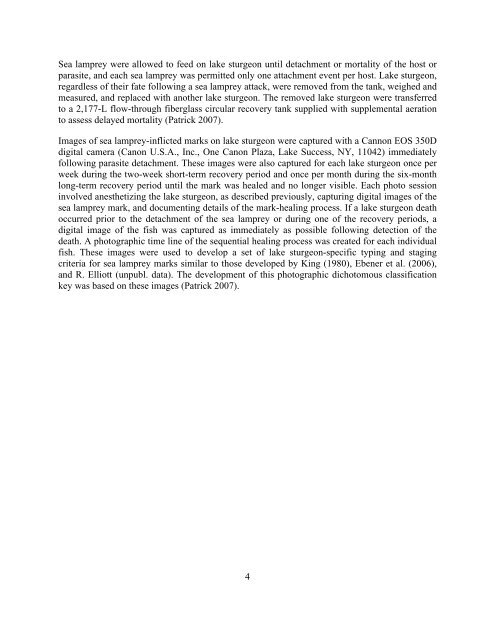application of a dichotomous key to the classification of sea lamprey ...
application of a dichotomous key to the classification of sea lamprey ...
application of a dichotomous key to the classification of sea lamprey ...
You also want an ePaper? Increase the reach of your titles
YUMPU automatically turns print PDFs into web optimized ePapers that Google loves.
Sea <strong>lamprey</strong> were allowed <strong>to</strong> feed on lake sturgeon until detachment or mortality <strong>of</strong> <strong>the</strong> host or<br />
parasite, and each <strong>sea</strong> <strong>lamprey</strong> was permitted only one attachment event per host. Lake sturgeon,<br />
regardless <strong>of</strong> <strong>the</strong>ir fate following a <strong>sea</strong> <strong>lamprey</strong> attack, were removed from <strong>the</strong> tank, weighed and<br />
measured, and replaced with ano<strong>the</strong>r lake sturgeon. The removed lake sturgeon were transferred<br />
<strong>to</strong> a 2,177-L flow-through fiberglass circular recovery tank supplied with supplemental aeration<br />
<strong>to</strong> assess delayed mortality (Patrick 2007).<br />
Images <strong>of</strong> <strong>sea</strong> <strong>lamprey</strong>-inflicted marks on lake sturgeon were captured with a Cannon EOS 350D<br />
digital camera (Canon U.S.A., Inc., One Canon Plaza, Lake Success, NY, 11042) immediately<br />
following parasite detachment. These images were also captured for each lake sturgeon once per<br />
week during <strong>the</strong> two-week short-term recovery period and once per month during <strong>the</strong> six-month<br />
long-term recovery period until <strong>the</strong> mark was healed and no longer visible. Each pho<strong>to</strong> session<br />
involved anes<strong>the</strong>tizing <strong>the</strong> lake sturgeon, as described previously, capturing digital images <strong>of</strong> <strong>the</strong><br />
<strong>sea</strong> <strong>lamprey</strong> mark, and documenting details <strong>of</strong> <strong>the</strong> mark-healing process. If a lake sturgeon death<br />
occurred prior <strong>to</strong> <strong>the</strong> detachment <strong>of</strong> <strong>the</strong> <strong>sea</strong> <strong>lamprey</strong> or during one <strong>of</strong> <strong>the</strong> recovery periods, a<br />
digital image <strong>of</strong> <strong>the</strong> fish was captured as immediately as possible following detection <strong>of</strong> <strong>the</strong><br />
death. A pho<strong>to</strong>graphic time line <strong>of</strong> <strong>the</strong> sequential healing process was created for each individual<br />
fish. These images were used <strong>to</strong> develop a set <strong>of</strong> lake sturgeon-specific typing and staging<br />
criteria for <strong>sea</strong> <strong>lamprey</strong> marks similar <strong>to</strong> those developed by King (1980), Ebener et al. (2006),<br />
and R. Elliott (unpubl. data). The development <strong>of</strong> this pho<strong>to</strong>graphic <strong>dicho<strong>to</strong>mous</strong> <strong>classification</strong><br />
<strong>key</strong> was based on <strong>the</strong>se images (Patrick 2007).<br />
4
















